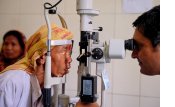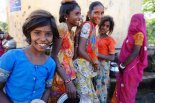Feedback/Comments from Our Readers
|
 Comments, questions and feedback is always welcome. Comments, questions and feedback is always welcome.
With summer approaching we have decided to send out a monthly version of the Global Health Weekly. It will return as a weekly newsletter mid August 2018.
|
|
Thanks to everyone for taking their time to come and join Global Health Rounds with us this year. With everyone's busy day to day schedule we are going to wrap up this year's Academic year. We look forward to the next upcoming academic year.
We're always looking for new speakers and ideas for topics for Global Health Rounds for the new coming up academic year in the Fall 2018. If you have speakers or topics, please contact Cheryl Knowles at GHFoMD@ualberta.ca. |
|
Now in Sight: Success Against an Infection That Blinds
|
 Fifteen years ago, Shiva Lal Rana walked 20 miles to Geta Eye Hospital to ask doctors to pluck out all his eyelashes.
Trachoma, a bacterial infection, had swollen and inverted his eyelids. With every blink, his lashes raked his corneas.
“The scratching hurt my eyes so much I could barely go out in the sun to plow,” he said. “I was always rubbing them.”
Worse, he feared the fate that others with the infection had suffered. The tiny scratches could accumulate and ultimately blind him.
To read more about this article go to https://www.nytimes.com
|
|
Opinion: How Tobacco Control can Boost Sustainable Development
|
|
The global economy loses $1.4 trillion every year due to tobacco use, according to a landmark monograph from the United States’ National Cancer Institute published last year. The damage to the environment occurs across the entire life cycle of tobacco products due to deforestation, water pollution from pesticide use, and cigarette littering. Premature deaths and disabilities caused by tobacco use have huge social impacts — particularly among lower-income communities members who are more likely to smoke.
|
|
Health Coverage Must Not Ignore Africa’s Elderly
|
My grandmother is 76, and my grandfather is 83. They have lived fruitful lives together, cultivating crops and grazing cattle in a remote village in the hills of southwest Uganda. But whenever I think of them, I am more in awe of their good health than their hard work.
Because of the remoteness of their community, anytime my grandparents need medical care, they must travel 25 miles to the nearest hospital on motorcycles known as boda-bodas, paying about 50,000 Ugandan shillings (about $13) for the round-trip journey. Then, because they were recently dropped from their health-insurance plan due to age, they must cough up more money to foot the bill for treatment. In other words, for my grandparents – and for many older Africans – a visit to the doctor is onerous, costly, and exceedingly rare.
To read more about this article go to https://www.project-syndicate.org/
|
|
The Girl-Shaped Hole in Global Health Data
|
 Sapna Singh, a wide-eyed teenage girl from rural Uttar Pradesh, India, used to grow dizzy and faint as many as six or seven times per month. The dizzy spells seemingly struck at random, she says, forcing her to miss days at school, from which she has since dropped out.
Singh’s health has finally begun to improve in the last year, thanks to a woman who runs the local Anganwadi, a rural women and children’s health center. She told Singh she seemed to be suffering from anemia, or khoon ki kami (lack of blood) in Hindi, and prescribed her weekly iron and folic acid (IFA) supplements. Phoolkumari Singh, the Anganwadi worker, tracks her consumption of the supplements in a wide record book with a pink cover and pages with cartoons describing symptoms of anemia.
“Now, I can work more than before, and get less tired than before,” says Sapna Singh. She says the supplements have given her strength for tasks she once struggled to complete, including cooking, fetching water and helping with farm labor in her village. This energy is particularly important in their village of Adampur Barethi, which sits amid wheat fields dotted with mango, guava and papaya trees.
Singh is lucky; millions of adolescent girls across India do not get the benefit of this simple and inexpensive intervention.
|
|
The Human Costs of Epidemics are Going Down but the Economic Costs are Going Up
|
 This year marks the 100th anniversary of the deadliest epidemic in history - the 1918 Spanish Influenza outbreak, which killed around 50 million people.
More recently, several outbreaks with equally familiar names have made headlines: SARS, swine flu, MERS, Ebola, Zika, yellow fever, Lassa fever, cholera, drug resistant infections... the list could go on. In fact, every month the World Health Organization receives 5,000 early-warning disease signals from across the globe, around 300 of which need further investigation and of which 30 warrant more in-depth field studies to investigate their potential for causing epidemics.
The number and kind of infectious disease outbreaks has increased significantly over the past 30 years. And as global trade and travel increases, so does the international spread of disease - and so does the economic impact of outbreaks. According to World Bank estimates, the annual global cost of moderately severe to severe pandemics is roughly $570 billion, or 0.7% of global income.
|
|
|
|
Save the Dates of Local Events!
|
Global Health Rounds
to return in the Fall 2018
|
|
Conferences, Symposiums & Lectures
|
Save this link to your favorites as I update it daily will all events, symposiums, etc., just click here.
CUGH 2019 Global Health Conference Translation
and Implementation
for Impact in Global Health
Date: March 8 - 10, 2019
Where: Hilton Chicago Hotel
|
|
Call for Abstracts/Submissions
|
|
Details to follow in the Fall Term 2018
|
|
Newsletter & Special Journal Editions
|
|
|